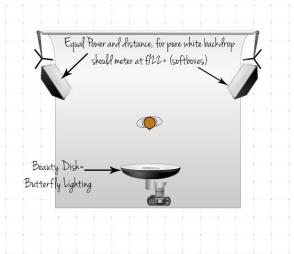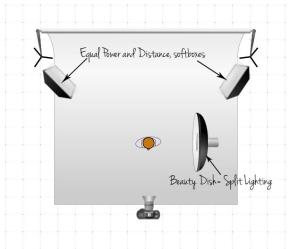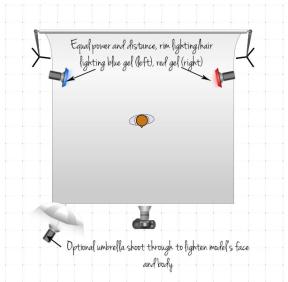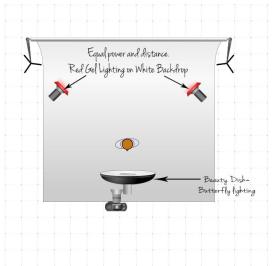It only took me 3 years…but I’ve finally gotten round to updating here with some of my HND coursework – which should hopefully explain in more detail the reasonings behind my final imagery for each unit. Classic Fashion was the second unit on my 2nd year – and you can view my final outcomes here: Classic Fashion Final Images
Classic Fashion – Evaluation
Introduction
The subject for these units is Classic Fashion. My work for this brief I needed to produce a set of fashion photography images. My starting point began with researching into the work of fashion designers like Issey Miyake and Yohji Yamamoto and fashion photographers such as Sølve Sundsbø, Nick Knight, Tim Walker, Paolo Roversi, Irving Penn, Emily Soto, Lara Jade and Rankin.
I researched and took references from high end fashion magazines and luxury magazines such as Rankin’s Hunger magazine and 125 magazine. I also collected various images from Internet research and books which I used as primary research.
The fashion concepts I decided on needed to be ones for which I could develop a meaningful narrative for, and ideas where I could demonstrate and showcase my studio skills at the same time as challenging me to try something new.
From my initial and detailed research I generated a detailed proposal where I developed my ideas. I completed and shot test images which helped me develop my ideas and techniques for the final images for my proposal, and then I chose my final images.
Detailed Research, Essay and Artist Research
My Initial research into the work of fashion designers like Issey Miyake and Yohji Yamamoto and fashion photographers such as Sølve Sundsbø, Nick Knight, Tim Walker, Paolo Roversi, Irving Penn, Emily Soto, Lara Jade and Rankin, and along with my research and references from high end fashion magazines and luxury magazines such as Rankin’s Hunger magazine and 125 magazine, together with the various images collected from Internet research and books, all provided me with a solid base for starting my essay.
The subject for my essay and concept for my set of fashion images was ‘East meets West’ – to discuss the relationship between culture, fashion and photography, and the concept of ‘East meets West’ from both a fashion and photography interpretation, and also culturally in the context of demographic trends – to reflect the demographic shift that is impacting the fashion markets both in countries in the West and in the East, where older women are now massively outnumbering the young.
From developing my essay I then collated additional information from fashion magazines catering to an older demographic, such as Violet magazine which primarily targets the 30+ age market and utilises mature models, and I identified Paolo Roversi and Nick Knight as key protagonists who make use of older models in their work. I also discovered works by lesser known fashion photographers such as Japanese avant-garde photographer and film director Sayaka Maruyama who used Western models, but attired in Eastern-inspired clothes, as well as other photographers such as Alexi Lubomirski who have produced shoots for leading fashion magazines such as Vogue Germany and Nicoline Patricia Malina, who produced a similar body of ‘East meets West’ work.
Idea Generation & Proposal
I intended to produce images using an older model, a white middle aged adult female model, but wearing Eastern inspired fashion to convey the correlation between ‘East meets West’ and the demographic shift that is facing the fashion industries in both cultures, whilst incorporating the main tenet of the brief, high-end fashion imagery.
For both ideas I intended to include relevant props to reinforce the Eastern influences in the clothing, and utilise lighting techniques such as gels to add Eastern inspired moods to my images.
The detail of my two ideas:
Idea 1 – ‘East Meets West, Minimalism’ – I want to depict an image that is clearly Western influenced, with contemporary Eastern fashion in the form of kimono tops, as well as swathes of fabric with oriental print and potentially props such as fans and parasols deployed as accessories, set against a minimalist backdrop of pure white, so the viewer’s focus is purely on the garment I am showcasing. I intend to use a mature model to depict the overall demographic change in society and to appeal to a wider audience.
Connotation: By using a clearly Caucasian model dressed in Asian influenced attire, it juxtaposes the two cultures as clearly black and white at first glance, yet in reality unveils the similarities betwixt British culture and culture in Asia, with both influenced by the other. The usage of an Middle Aged model showcases the demographic shift in audience, as both East and West’s population gets older.
Denotation: Female model dressed in pseudo traditional Asian attire with either Butterfly lighting or Split lighting/Broad lighting against a white backdrop.
Idea 2 – ‘East Meets West, Gels’ – I want to depict an image that is Western influenced, with contemporary Eastern style fashion by utilising different swathes of fabric in various oriental floral prints as kimono tops and belts. I will combine oriental printed fabric with atypical western style dress, for example evening dress or suits to create a strong juxtaposition between the two cultures. I intend to use a mature model to depict the overall demographic change in society and to appeal to a wider audience. I will use gel lighting either as a means for changing my backdrop colour (primarily to red) or I will use gel lighting as hair/rim lighting and potentially even split lighting on my model (probably in blue and red).
Connotation: By using a clearly Caucasian model dressed in Asian influenced attire, it juxtaposes the two cultures as clearly black and white at first glance, yet in reality unveils the similarities betwixt British culture and culture in Asia, with both influenced by the other. The usage of an middle aged model showcases the demographic shift in audience, as both East and West’s population gets older.
Denotation: Female model dressed in pseudo traditional Asian attire with either Butterfly lighting against a red gelled backdrop or Split lighting/Broad lighting, with either hair lighting as blue and red gels or as completely split lighting.
Props, Materials & Model
I researched and sourced various suitable props and materials that I would need to shoot my concept ideas, including:
- A selection of ladies printed kimono jackets
- Ladies vintage 1920s ‘flapper’ dress
- Other ladies clothing and accessories, e.g. blouse, culottes, belt, scarf, hat
- Ladies wigs
- Make up – lipstick, face powder
- Assorted ladies Jet jewellery
- Props – Chinese/Japanese fans in a variety of sizes and parasol
- Female adult model
Risk Assessment
I included a review and risk assessment of the Health and Safety risks in the studio, in particular the risks surrounding having props and a model in the studio, as well as a general risk assessment, including use of studio flash equipment that could multiply heat issues, e.g. gels and beauty dish.
Shoots
Idea 1 – ‘East Meets West, Minimalism’
Equipment:
Mature female model in East meets West fusion attire with props, Olympus OM-D E-M5, Olympus 45mm 1.8, Panasonic Leica DG Summilux 25mm 1.4, tripod, IKEA roller-blind in white, White fabric backdrop + stands
Light modifiers for studio lights: Beauty Dish, Softboxes.
Studio Flash @ 1/125 ISO200 F/8- F/16
 |
 |
For ‘East meets West, Minimalism’, I primarily used a white 2mx3m backdrop (with the white IKEA roller-blind being used for close ups), which was lit evenly by using two soft-boxes with equal power, distance and angles between (on the left and the right) pointing at the backdrop, measured at f/45 to produce a pure white uniform backdrop. My model was lit by a beauty dish in either split lighting mode or butterfly lighting mode, which gave a uniform soft almost flat lighting to the model’s face and body, with no harsh shadows. I utilised a selection of props for either the model to hold or be placed against the backdrop- primarily oriental fans of various sizes and parasols. I shot the model is several poses and several variations of ‘East meets West’ fashion, by styling various strips of fabric as different parts of garments such as belts or skirts. Editing ‘East meets West, Minimalism’ consisted of minor adjustments to levels, spot healing/cloning tool and blur tool to smoothen out blemishes such as excess wrinkles.
Idea 2 – ‘East Meets West, Gels’
Equipment:
Mature female model in East meets West fusion attire with props, Olympus OM-D E-M5, Olympus 45mm 1.8, Panasonic Leica DG Summilux 25mm 1.4, tripod, IKEA roller-blind in white, White fabric backdrop + stands
Light modifiers for studio lights: Beauty Dish, Shoot through Umbrella, Barndoors with gels in red and blue.
Studio Flash @ 1/125 ISO200 F/5.6-F/11
 |
 |
For ‘East meets West, Gels’, I primarily used a white 2mx3m backdrop (with the white IKEA roller-blind being used for close ups), which was either lit evenly by using two red-gelled barn doors with equal power, distance and angles between (on the left and the right) pointing at the backdrop, measured at f/8 to produce a rustic red uniform backdrop or lit only by minor bounce back of the rim/hair-lights of the split lit blue and red gelled barndoors. My model was either lit by a beauty dish in or butterfly lighting mode, which gave a uniform soft almost flat lighting to the model’s face and body, with no harsh shadows or was lit by an umbrella shoot through to lighten elements of the model’s face and body that was lit by the blue and red gels. I utilised a selection of props for either the model to hold or be placed against the backdrop – primarily oriental fans of various sizes and parasols. I shot the model is several poses and several variations of ‘East meets West’ fashion, by styling various strips of fabric as different parts of garments such as belts or skirts. Editing ‘East meets West, Gels’ meant minor adjustments to levels, spot healing/cloning tool and blur tool to smoothen out blemishes such as excess wrinkles.
Model Release
For these Units I researched for and found a suitable formal Model Release form, which I used to provide a formal contract and terms between the photographer and the model I deployed in my shoots.
Presentation and Critique
I exhibited my work displayed in framed, mounted prints. I also presented my sketchbook work and displayed my set of four final fashion images. Following my presentation I received 5 critique responses to the following questions which are collated together (original copies of the responses attached):
Q1. Did they use their time effectively in your opinion? How so?
- “Good extensive research, to artists and magazines”
- “Everything completed. Lots of lovely research in sketchbook and nice mood boards”
- “Good research/clear links, good usage of outside resources”
- “At the start everything is linked from artists to her first shoot”
- “As usual sketchbook doesn’t disappoint. Very, very detailed”
Q2. Do you think the final work is successful in terms of hitting the targets they set in the planning stages? What improvements would you suggest and why?
- “Yes clearly linked to culture, some beautiful colours+lighting – Gels! Possibly could have done a full length”
- “Clear development and links well to sketchbook”
- “Maybe use a multicultural model or use some location”
- “Yes, very good final images, well lit, would like to see more diversity in models”
Q3. Did they plan and prepare their presentation? What more do you think they could have done?
- “Clear + concise opinions brought forward”
- “Smooth, clear and informative”
- “Good showcase of work”
- “From the beginning of the sketchbook everything is heavily linked. At the final images you don’t get just an understanding what she is talking about”
Q4. Did they use available resources well? What did they do well?
- “Yes very good use of studies + resources such as books, Internet, mags”
- “External model and external studio”
- “Good usage of resources outside of college”
- “From working at home you have managed to create final images and sketchbook that is full to the brim”
- “Your images show good control of lighting + gels, so yes”
Q5. Did they communicate their ideas and project well? What improvements could you suggest for next time?
- “Yes – nice ref to different fashion imagery”
- “Clear intentions. Maybe experiment with composition – try out ‘flowing’ things you have previously researched”
- “Yes very good”
- “Looking at the final images you interpreted the references she is trying to connect”
- “Very well communicated. A lot of in-depth”
Q6. Do you think they hit the brief well? What else could they have done?
- “Definitely, culture is clearly shown – sketchbook, coherent”
- “Strong cultural element”
- “Not much else even background on red ”
- “More so, very extensive work”
Q7. (Subject Specific) Do you think their work was completed technically well? What improvements would you suggest?
- “Yes, good use of Gel. Nice lighting”
- “Nice lighting techniques”
- “Good use of gel lighting”
- “Good control of gels, this is a hard thing to do”
Q8. What is the strongest element of their project? What did you like the most?
- “Sketchbook. But images especially Gel image was very good – really liked it”
- “Really good final images, impressive sketchbook”
- “Sketchbook + good final set”
- “Consistency in final images, well framed”
General Comments:
- “Lighting on red + gel – could have picked out details on lower body”
- “Set considerations – parasol not as dominant”
- “Pose/composition – distance, different, maybe full length? More models?”
Conclusion
I felt that these units were successful in terms of my proposal concepts and their outcomes. My essay and in-depth research into the challenges facing the fashion industry as a whole, of how to respond to the demographic shift that is affecting the developed fashion markets in both the West and East where older women are outnumbering the young, provided valuable insights into both cultural aspects and also how professional photographers are, or aren’t, addressing this issue.
My essay and research helped me generate the ideas and concepts for my proposal, which then allowed me to successfully plan, prepare and complete my shoots. This then helped me to achieve, accomplish and select my set of four final images, which I feel fully actualise the brief of ‘Classic Fashion’, and the images also accomplish my personal objective to utilise a mature adult female model as an alternative to the overused and hackneyed young models, as this is a demographic with limited and frequently low incomes.
My choice of a mature UK size 10 model was primarily driven by my target demographic, but I also wanted to use a model that represented the body image valued by the mature fashion market in countries such as China and Japan, and one that was closer to the real size of the modern average woman in the UK (where the average is size 16, 5’ 13” in height and weighing 11 stones [1], versus a typical Western model size 6/8, 5’ 11” in height and weighing around 8.5 stones[2]). The influence of the stereotypical ‘anorexic’ fashion model in countries such as China and Japan has only begun in the last 30 years, meaning that they still have older, more traditional value and belief systems and beauty standards, where curvaceousness equates to health, wealth and fertility, so marketing fashion to their older, more affluent adults needs to reflect this.
I also researched what represents current fashion trends for the older demographic in Eastern countries such as Japan or Korea. Unlike Western countries, Eastern fashion trends to trail behind the West, with strong historical precedents to 1920s to 1950s American and European fashions, featuring for example S-Line (curvy figure) dresses, where the ‘S’ is used to visually describe a curvy woman. Additionally in Eastern countries such as Korea a pale complexion signifies wealth, health and luxury, whereas only the poor and peasants have tanned complexions – while in Western countries the reverse is true and a tan represents perceived wealth and health.
I feel my four final images visually express the concept of ‘East meets West’, both in terms of conceptual fashion design and as high end fashion photography, with each image capturing the spirit and ethos of “East meets West”, all channelled through the symbolism of a mature model reflecting the shifting demographic customer base of the fashion industry.
Overall I found these units to be questioning, inducing me to seek out a niche alternative approach to the predictable solution to “East meets West”, which motivated me to challenge my skills and work with a more problematic model which required me to develop my studio lighting techniques, while also being successful and rewarding in achieving my final images. I am very satisfied with my set of final images, and particularly the lighting techniques I used to create them, which I can deploy for clients as a professional photographer.
The feedback responses I received to my presentation were all very positive and constructive, endorsing that my detailed research, sketchbook work, ideas, experimentation using an older model and final images were all very successful. Generally the comments provided me with a few minor pointers as to where I could improve.
I feel that the four images that I selected as my set of final images meet the brief and match the ideas and concepts I generated from the analysis of the relationships between culture, fashion and photography in my essay and subsequently transcribed into my proposal, which were supported by my detailed research and annotation. I am also pleased with my studio lighting techniques and subsequent post-processing in Photoshop, particularly the my use of gel based lighting. The images I produced I believe could easily be used in high-end fashion magazines and successfully communicate the connotation of ‘East meets West’ and demographic change, evoking the works of fashion photographers such as Paolo Roversi.
Working in my temporary home studio was challenging and did pose me with a number of challenges and restrictions that I had to work within. For example, I encountered issues with restricted width and length, meaning that I could just about shoot a full head to toe full body shot of my model. I also had issues with the new backdrop which I purchased for this shoot. Despite being 2m wide and 3m in length, the length was not sufficient to allow me to bring my model forward enough from the backdrop, and as a result I encountered lighting pollution/spillage from competing lights. Additionally the backdrop was badly creased due to being packaged for delivery, and despite following the instructions I was unable to satisfactorily remove the creases so I did not use the backdrop and I reverted to using my standby white IKEA roller blind instead. To avoid this in the future I will purchase a roll of backdrop paper which I then can extend further than 3m to allow separation between my models and the background.
Working through these issues and restrictions has positively benefited my learning. I have gained very valuable experience of working in restricted spaces and overcoming the issues they can present. This has helped to develop my skills further and provides me with an additional skillset to apply if I encounter a similarly restricted situation in my professional career.
These Units have reaffirmed my previous learning in terms of shooting in the studio, whilst also allowing me to refine my skills with gel lighting and with more challenging and problematic model subjects, allowing me to gain very valuable experience which I can use when dealing with clients who are either older themselves or those that wish to communicate and engage with the most ubiquitous demographic that has the highest disposable income to buy all forms of fashion. Researching for my essay provided me with valuable insights into fashion as an industry and the array of potential opportunities and niche markets that are open for me to exploit in my future career. The objective of creating ‘Classic Fashion’ images presented me with valuable new prospects to enhance my expertise when working with models in the studio, along with developing and consolidating my lighting skills and other image making techniques.

Some of the Final Outcomes- I culled the first two left – as they were more middle eastern inspired rather inspired by the Orient.
